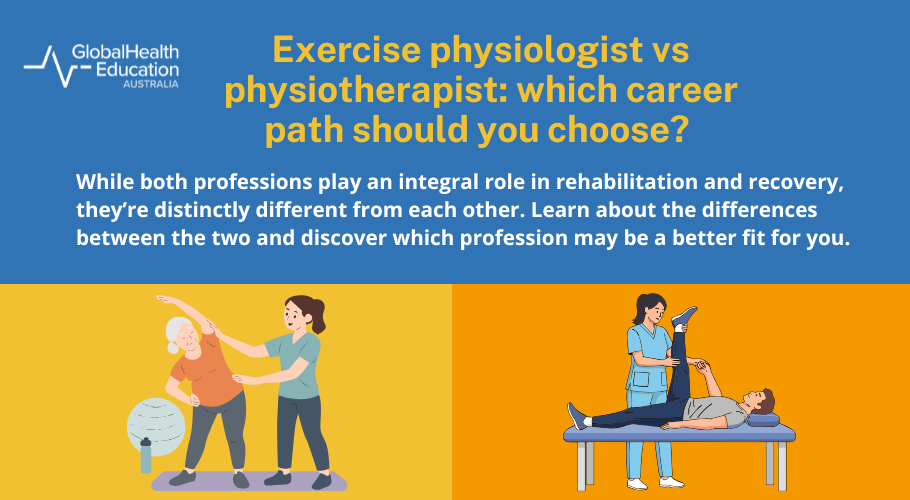In This Article
- Data at a glance
- Roles and responsibilities
- Salary
- Qualifications
- How to become an exercise physiologist or a physiotherapist?
- Should I become an exercise physiologist or physiotherapist?
- Key differences summed up between an exercise physiologist vs physiotherapist in Australia
- Finding the right fit for you
Exercise physiologists and physiotherapists share “physio” in their title but they differ in areas such as their scope of practice, education pathways and approach to treatment.
Physiotherapy is a field most individuals are familiar with and the profession continues to be in high demand with a projected job growth of 28.7 per cent over the next five years. Exercise physiology, on the other hand, is an emerging field with a job growth of 3.5 per cent predicted over the same period.
If you’re considering which profession to pursue, this article breaks down key differences between the two, exploring areas such as salary, responsibilities and qualifications required.
Exercise physiologist vs physiotherapist: data at a glance
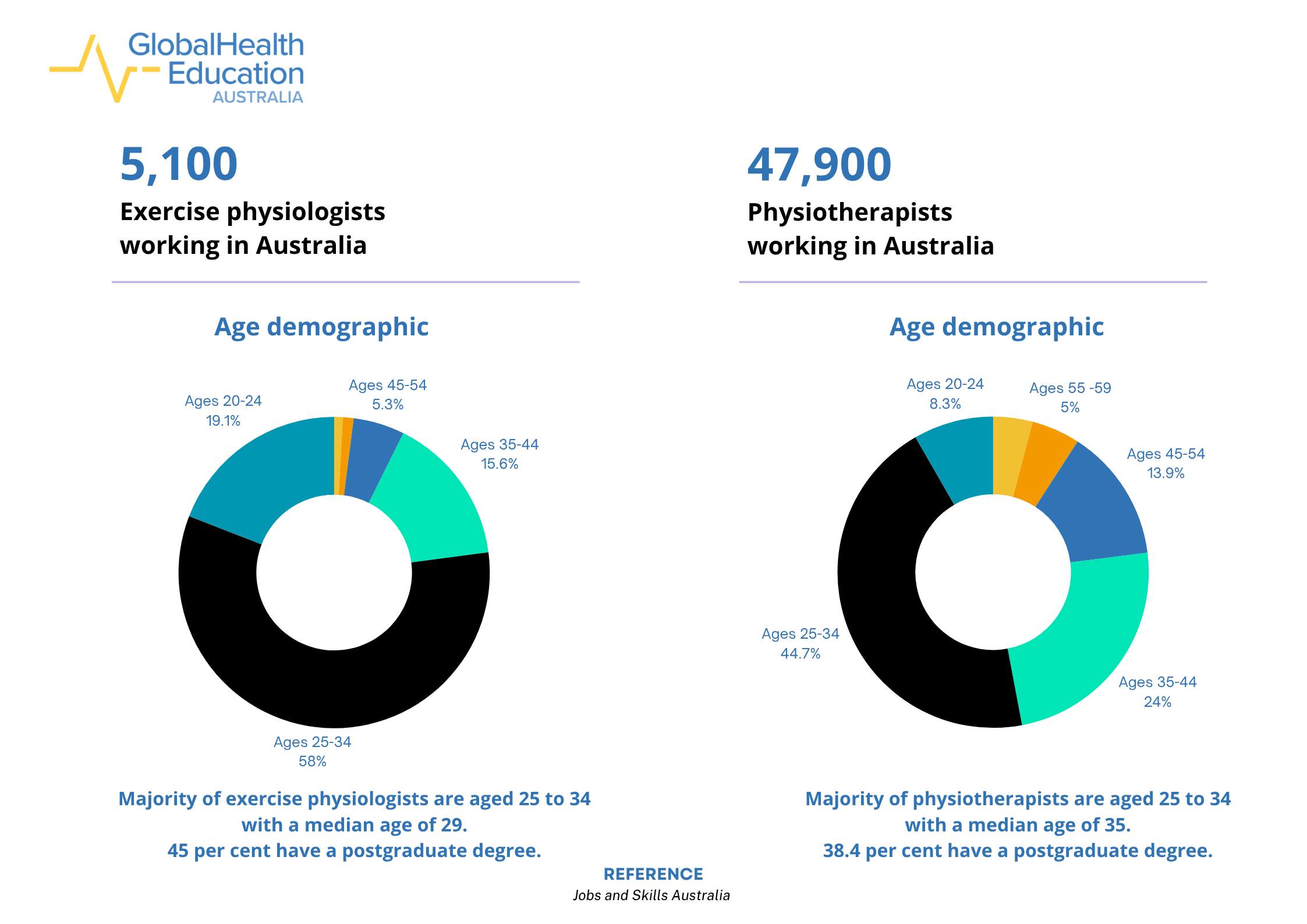
Exercise physiologist vs physiotherapist: roles and responsibilities
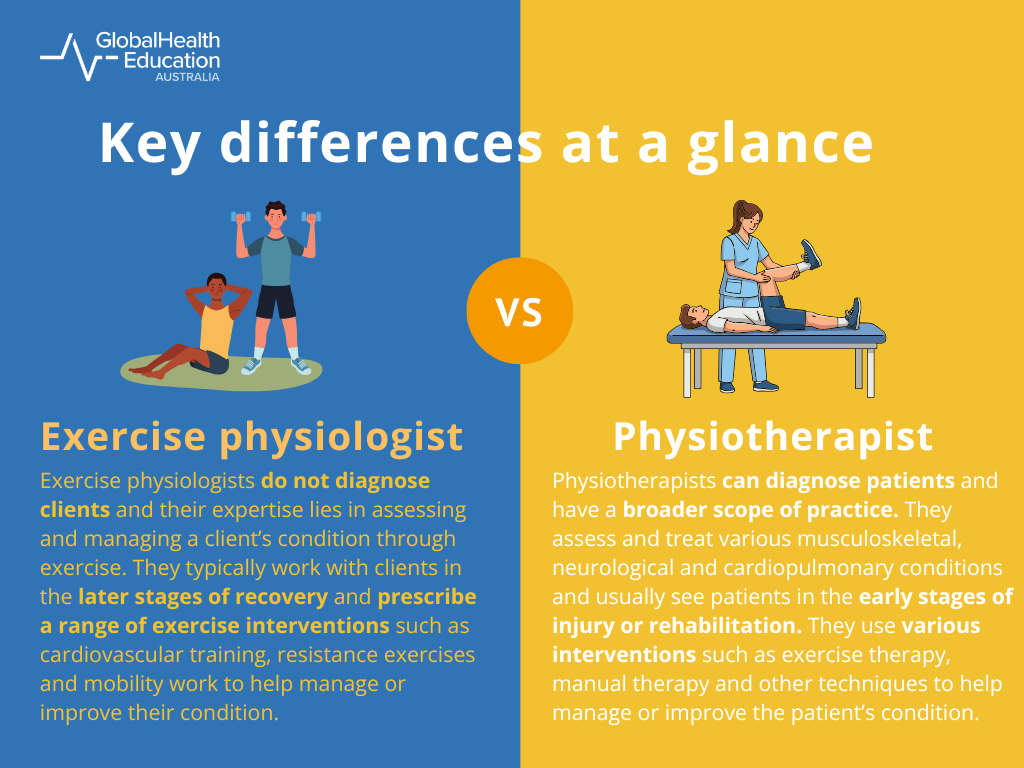
Both physiotherapists and exercise physiologists play an important role in rehabilitation and recovery, however, their focus and treatment approaches differ.
What do exercise physiologists do?
Exercise physiologists are allied health professionals who specialise in using exercise and movement-based interventions to treat a wide range of physical and mental health conditions. Much like how a doctor prescribes medication, exercise physiologists prescribe exercise as medicine, using movement to help manage chronic health conditions, enhance recovery and optimise performance.
Assessing clients
Exercise physiologists don’t diagnose conditions and clients are usually referred to them by physiotherapists, GPs or other healthcare professionals. Each session typically begins with an initial assessment where exercise physiologists assess areas such as body composition, strength, flexibility and movement quality.
Prescribing exercise programs
Once the assessment is complete, a personalised exercise program is designed based on the client’s goals, abilities and health needs. These programs may include aerobic conditioning, mobility exercises, resistance training or adaptive exercises.
Providing education and support
Beyond exercise programming, exercise physiologists also provide education and guidance. They help clients understand how physical activity benefits their condition, demonstrate correct exercise techniques and offer guidance on building sustainable lifestyle habits.
When would someone typically see an exercise physiologist?
You would typically see an exercise physiologist if a physiotherapist or medical professional has recommended an exercise-based approach for your condition. This could be for:
- Rehabilitation following an injury or surgery
- Managing chronic conditions such as cardiovascular disease, diabetes or obesity
- Managing mental health conditions such as anxiety, stress or depression
Other than the above, athletes or individuals looking to improve their overall fitness might also see exercise physiologists to work on strength and conditioning or to achieve specific performance goals.
What a day in the life of an exercise physiologist might look like
Sessions with new or regular clients
Most exercise physiologists begin their day with client sessions. Depending on where they work, they may run one-on-one sessions or facilitate group sessions.
One-on-one sessions typically involve the exercise physiologist supervising and coaching clients through their prescribed exercise program. They would watch movement quality, adjust technique and review the client’s progress. They might also prescribe a gradual amount of progression such as increasing weights or adding repetitions on the different exercises based on how the client is responding to the program.
Group sessions might involve leading structured classes such as hydrotherapy, balance and falls prevention and women’s exercise. Exercise physiologists can also lead group exercise programs for individuals managing chronic conditions such as Parkinson’s disease or knee or hip osteoarthritis.
They could also be working with a new client, for example, someone recovering from neck surgery. In that instance, they would begin by conducting an initial assessment before creating a personalised exercise program that might involve cardiorespiratory and strength-based exercises that are catered to the individual’s needs and goals.
Education is also a big part of the role as they often provide advice on safe exercise practices, lifestyle changes and long-term strategies to maintain physical wellbeing.
Behind the scenes
Outside of their client sessions, exercise physiologists often juggle a few other responsibilities, which may include planning and updating exercise programs, writing progress notes and staying up-to-date across the latest research and best practices.
What do physiotherapists do?
Physiotherapists are allied health professionals who diagnose, manage and treat various musculoskeletal, neurological and cardiopulmonary conditions. They use a mix of treatment approaches to help people recover from injury, reduce pain, restore mobility or improve their mental health.
Diagnosing clients
Physiotherapists are qualified to diagnose a range of conditions that affect movement and function. A session usually begins with a chat about the patient’s medical history and current symptoms. This is followed by a physical examination to assess factors such as range of motion, strength and flexibility.
Creating a customised treatment plan
After the diagnosis, a treatment plan tailored to the patient’s individual needs is developed. This plan may include manual therapy, exercise therapy, clinical Pilates or other treatment modalities to assist with supporting recovery or enhancing mobility.
Educating patients
Similar to an exercise physiologist, a physiotherapist also educates patients. They may do this by teaching specific exercises, providing ergonomic advice and offering lifestyle recommendations to help manage symptoms and prevent future injuries.
When would someone typically see a physiotherapist?
You would typically see a physiotherapist if you’re experiencing the following:
- Injuries such as muscle strains, sprains or stress fractures
- General aches and pains like neck or back pain caused by poor posture or lifestyle habits
- Rehabilitation and recovery after surgery such as joint replacements, or when managing a neurological condition
- Chronic pain management for conditions like arthritis and fibromyalgia
- Managing chronic diseases such as osteoporosis and Parkinson’s disease
Physiotherapists can also support individuals with mental health conditions by developing a treatment plan aimed at improving mobility and overall function. This may include body-based interventions such as breathing exercises and body awareness exercises.
What a day in the life of a physiotherapist might look like
Seeing patients
Similar to an exercise physiologist, a physiotherapist’s day usually revolves around a mix of new assessments and follow-up appointments.
For new patients, this involves a thorough assessment where the physiotherapist asks questions and performs physical tests which involve testing balance, strength, posture and flexibility to identify the underlying issue before developing a treatment plan.
For returning patients, it’s about checking in on their progress, making adjustments where needed and continuing treatment to help them reach their recovery goals.
Delivering treatments
Physiotherapists see a wide variety of clients, from those with sports injuries like tennis elbow to individuals dealing with neck pain or neurological conditions. Depending on the case, a physiotherapist may use hands-on techniques such as joint mobilisation or soft tissue therapy, or guide clients through targeted exercise programs designed to restore movement and strength.
For example, if a physiotherapist is working with someone with a neurological condition, they might spend time in the gym focusing on exercises that help improve balance, coordination and walking endurance.
Behind the scenes
Outside of client sessions, physiotherapists also have a range of administrative responsibilities that can include writing progress notes, responding to client emails, reviewing treatment plans and completing their continuing professional development (CPD) hours.
Exercise physiologist vs physiotherapist: salary
Exercise physiologist salary
How much an exercise physiologist earns can vary depending on factors such as location, experience and workplace setting. For example, while exercise physiologists in Australia typically earn between $80,000 and $90,000 per year, those working in Tasmania earn more, with an average salary of around $90,000 to $100,000 per year.
Physiotherapist salary
Similar to exercise physiologists, a physiotherapist’s salary can also depend on factors like experience, location and sector. According to SEEK, physiotherapists in Australia earn an average annual salary of between $85,000 and $100,000 per year, with those in the Northern Territory earning the most at around $105,000 to $125,000 per year.
The industry a physiotherapist works in can also influence earnings. For instance, physiotherapists employed in government and defence earn an average of $97,000 per year, while those working in community services and development average around $88,000 per year.
Exercise physiologist vs physiotherapist: qualifications
What qualifications do exercise physiologists need?
It typically takes around four years to become an exercise physiologist and you’ll need to complete a Bachelor of Clinical Exercise Physiology or equivalent.
It is highly recommended to choose a course that is accredited by Exercise and Sports Science Australia (ESSA), as this accreditation provides benefits such as greater employment opportunities, recognised professional standards and industry credibility.
What will you study?
While the exact course structure differs between universities, courses typically include clinical placements and cover areas such as:
- Human physiology and anatomy
- Exercise prescription and programming
- Biomechanics of human movement
- Nutrition
- Sports and exercise medicine
What qualifications do physiotherapists need?
To become a physiotherapist, you’ll need to complete a Bachelor of Physiotherapy, which typically takes around four years. After graduating, you must register with the Physiotherapy Board of Australia (PBA) through the Australian Health Practitioner Regulation Agency (Ahpra).
What will you study?
While course content can vary between institutions, a Bachelor of Physiotherapy generally includes clinical placements and covers topics such as:
- Physiotherapy anatomy
- Human biology
- Pathophysiology
- Cardiorespiratory physiotherapy
- Musculoskeletal physiotherapy
How to become an exercise physiologist or a physiotherapist?
How to become an accredited exercise physiologist
The flow chart below indicates the different ways that you can become an accredited exercise physiologist in Australia.
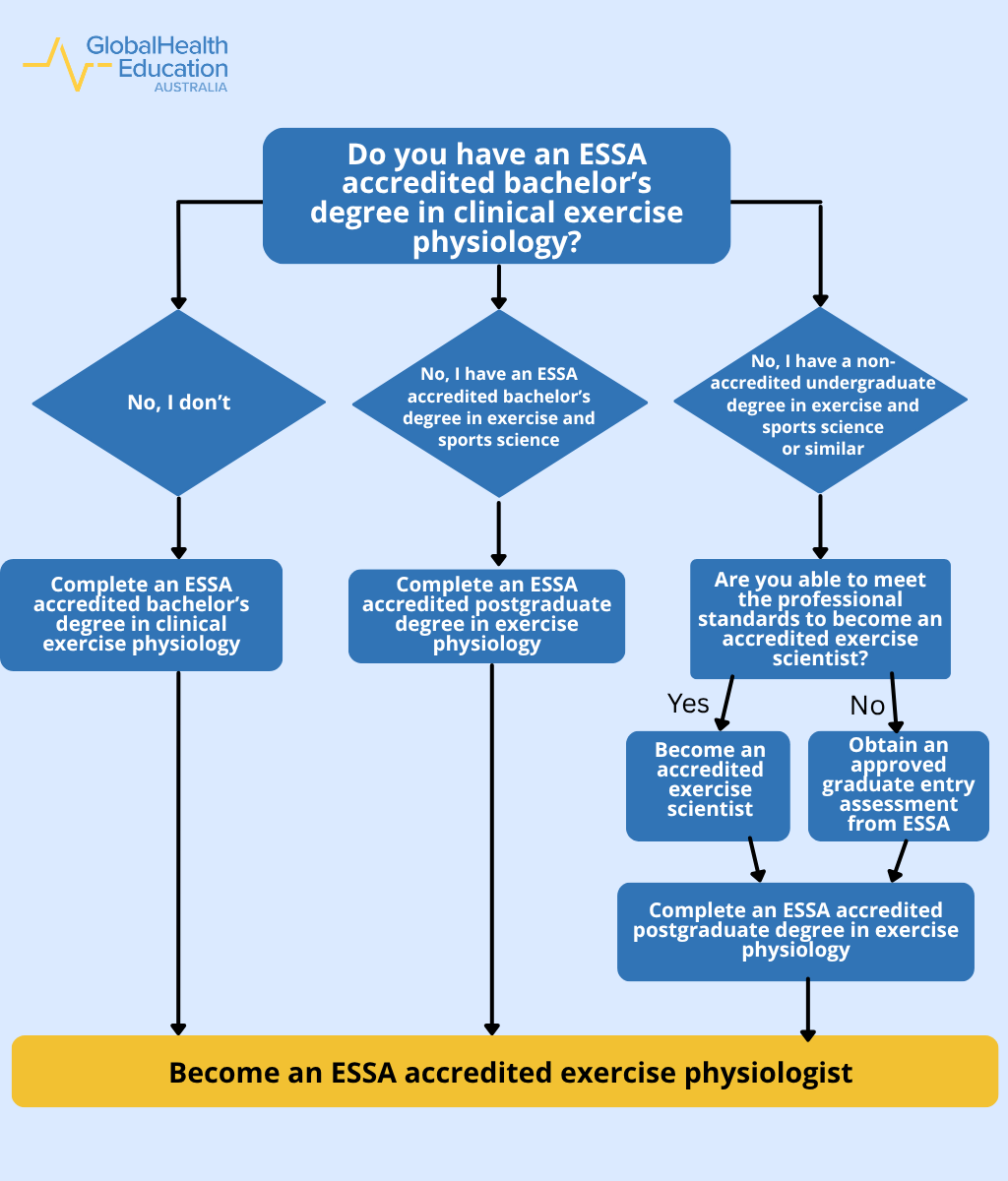
As seen from the flow chart above, the fastest way to become an ESSA accredited exercise physiologist is by completing an ESSA accredited bachelor’s degree in clinical exercise physiology.
Have an ESSA accredited bachelor’s degree in exercise and sports science instead of clinical exercise physiology?
To become an ESSA accredited exercise physiologist, you’ll need to complete an ESSA accredited postgraduate degree in exercise physiology.
Have a non-accredited undergraduate degree in exercise and sports science?
There are two main pathways to becoming an accredited exercise physiologist.
Pathway one: become an accredited exercise scientist first
If you’re able to meet all of the Accredited Exercise Scientist (AES) professional standards, you can first apply to become an accredited exercise scientist.
To meet the requirements, you’ll typically need to:
- Complete at least 140 hours of supervised exercise science practicum
- Meet AES professional standards
Or
- Have a minimum of three years of full-time experience as an exercise scientist
- Meet AES guiding principles within the AES professional standards
Thereafter, you would need to complete an ESSA accredited postgraduate degree in exercise physiology.
Pathway two: obtain a graduate entry assessment
If you're not able to meet all of the AES professional standards, you can apply for an approved graduate entry assessment through ESSA. The assessment will evaluate your academic coursework and practical experience against the AES professional standards.
Once you’ve received an approved graduate entry assessment, you can proceed to apply for an ESSA accredited postgraduate course in exercise physiology. As requirements can vary between institutions, it’s best to check the university’s website to determine your eligibility.
Hold a bachelor’s degree in another field such as human movement, athletic training, physical therapy or a related discipline?
Some universities may allow you to apply for their ESSA accredited postgraduate course in exercise physiology, provided you’ve completed a relevant postgraduate qualification at that university.
For example, Australian Catholic University allows students to be eligible for admission to their Master of Clinical Exercise Physiology course if they have completed a Graduate Certificate in Exercise Rehabilitation for Sports Injuries at the university.
How to become a physiotherapist
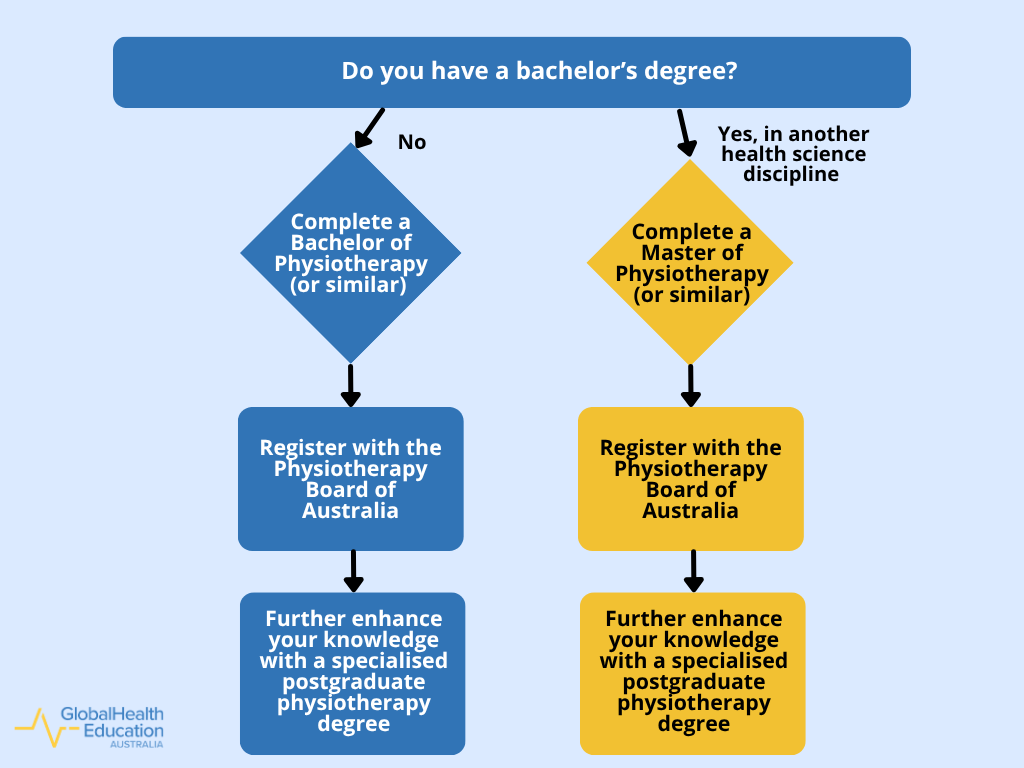
As shown in the chart above, there are two main pathways to becoming a physiotherapist. The fastest way is to complete a Bachelor of Physiotherapy (or equivalent) before registering with the Physiotherapy Board of Australia.
Alternatively, if you already hold a bachelor’s degree in another health science discipline, you may be eligible to apply for a Master of Physiotherapy. Here are a few courses to consider:
Master of Physiotherapy Studies at The University of Queensland
To qualify for this course, you’ll need a bachelor’s degree and have completed university-level studies in human anatomy and physiology. The course can be completed in two years full-time and includes advanced coursework, research and clinical placements.
Master of Physiotherapy at RMIT University
This two-year course will equip you with the skills and competencies required to practise as a physiotherapist. To be eligible, applicants must hold a bachelor’s degree in science, biomedical science, exercise science, health or a related discipline with a major or minor in human anatomy and human physiology. Applicants with at least two years of relevant industry experience may also be eligible for the course.
Master of Physiotherapy at Victoria University
This two-year full-time course is delivered on campus and requires applicants to have a bachelor’s degree in a cognate discipline, along with evidence of completing at least one anatomy, physiology and research unit.
After completing their studies and working as a physiotherapist for a few years, many choose to pursue further study to sharpen their skills or develop expertise in a particular area of practice.
If you’re looking to upskill in a shorter timeframe, here are a few courses to consider:
Graduate Certificate in Human Movement Science at the University of Canberra
This six-month course is ideal for those looking to further their careers in the sports or health sector and will strengthen your knowledge in functional anatomy, biomechanics and exercise physiology.
Graduate Certificate in Physiotherapy (Exercise and Women’s Health) at The University of Melbourne
Completed over one-year part-time, this course advances your skills in exercise and women’s health. You’ll complete units such as Exercise for Women and Musculoskeletal Disorders in Women and create a Physiotherapy Professional Portfolio.
Graduate Diploma in Physiotherapy (Paediatrics) at The University of Melbourne
Ideal for those looking to specialise in paediatric physiotherapy, this one-year full-time course covers units such as Paediatric Physiotherapy Theory and Rehabilitation for Paediatrics.
Have more time to invest in your development? Here are a few master’s-level courses to consider:
Master of Sports and Exercise Physiotherapy at Australian Catholic University
Develop the skills to enhance performance and promote wellbeing across all ages and abilities. Study units such as Physiotherapists Working in Sport, Sports Injury Prevention and Exercise Rehabilitation for Return to Sports Performance.
Master of Musculoskeletal Physiotherapy at La Trobe University
Gain advanced clinical skills in musculoskeletal physiotherapy with this two-year part-time course. You’ll study units such as Advanced Musculoskeletal Physiotherapy and Research to Inform Advanced Physiotherapy and also gain clinical practice experience under the supervision of sports and exercise physiotherapists.
Should I become an exercise physiologist or physiotherapist?
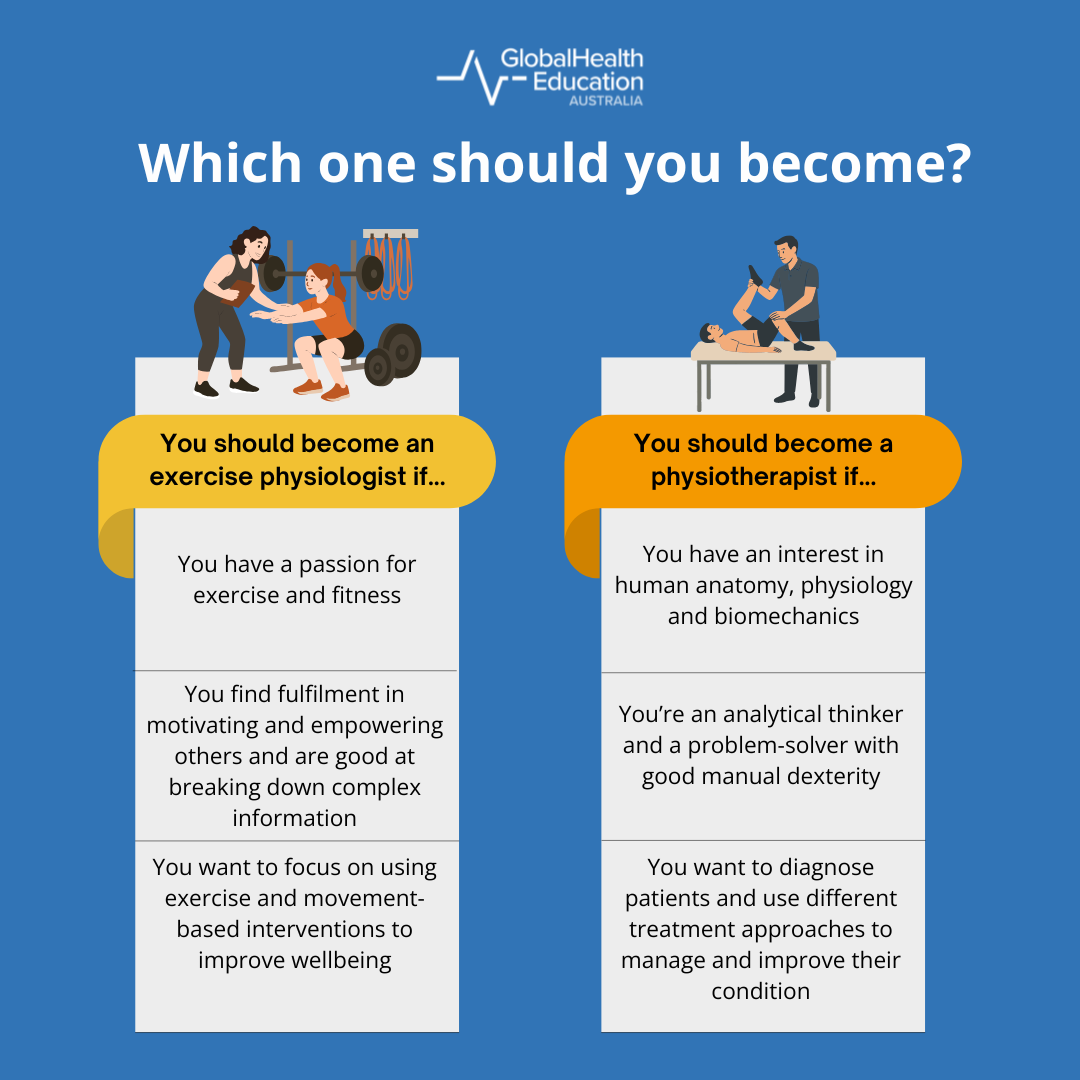
It depends on where your interests and strengths lie and how you like to work with people. If you enjoy empowering others through exercise and fitness and prefer a coaching-focused approach to treatment, you might be better suited to a career as an exercise physiologist.
If you’re interested in movement science and want to be able to diagnose conditions and learn a broad range of treatment techniques, physiotherapy may be a better fit.
Here are a few things to consider when deciding which career path is right for you:
What are your interests?
If you have a passion for exercise and fitness and want to use it to help people manage and improve their health, you might be drawn to a career as an exercise physiologist. In this pathway, you’ll be using exercise as the main tool for treatment and prevention, developing tailored programs to support recovery, build strength and enhance overall wellbeing. It’s an ideal career if you want to help clients improve their overall health through exercise.
If you have an interest in human anatomy, physiology and biomechanics and want to learn a wide range of techniques to restore movement and function, physiotherapy may be the ideal career path. As a physiotherapist, you’ll diagnose physical conditions and use a combination of manual therapy techniques, therapeutic exercises and treatment
Do you want to be able to diagnose conditions?
While you won’t be able to diagnose conditions as an exercise physiologist, as a physiotherapist, you can diagnose problems and injuries related to the joints, muscles, bones, nerves, tendons and ligaments of the body. If you want the ability to diagnose a person’s condition independently and not through a referral from another healthcare professional, becoming a physiotherapist could be the right fit for you.
How do you like to work with people?
Exercise physiologists generally have a hands-off approach to treatment. Their work focuses on educating, guiding and coaching clients to perform exercises safely and effectively. If you prefer empowering people to take charge of their health and wellbeing through instruction and education, you might be suited to a career as an exercise physiologist.
Physiotherapists, on the other hand, use both hands-on and hands-off approaches depending on the patient and their needs. You might, for instance, use manual therapy, massage or joint mobilisation to reduce pain and improve mobility or prescribe targeted exercises to support recovery. If you are interested in learning a wide variety of treatment methods, physiotherapy could be a good fit.
Where do your strengths lie?
Exercise physiologists require strong skills in clinical assessment, program design, health education and motivational coaching. If you enjoy building rapport with people, can communicate complex information in a simple and practical way and find fulfilment in motivating and empowering others, exercise physiology could be a great fit for you.
Physiotherapists, on the other hand, need strong clinical reasoning skills, attention to detail and manual dexterity for hands-on techniques. If you’re an analytical thinker who enjoys problem-solving and has good hand-eye coordination, you may enjoy working as a physiotherapist.
Key differences summed up between an exercise physiologist vs physiotherapist in Australia
| Category | Exercise physiologist | Physiotherapist |
|---|---|---|
| Roles and responsibilities | Focuses on using exercise and movement-based interventions to improve physical function and quality of life. | Can diagnose patients and uses a mix of treatment approaches to help patients improve and manage their condition. |
| Salary | Generally between $80,000 and $90,000 a year. | Earns approximately between $85,000 and $100,00 per year. |
| Qualifications | Takes approximately four years and involves completing a Bachelor of Clinical Exercise Physiology. | Takes approximately four years and involves completing a Bachelor of Physiotherapy. Individuals can also pursue a postgraduate physiotherapy course to enhance their skill set. |
| Work environment | Can work across diverse settings including gyms, hospitals, clinics and rehabilitation centres. | Can also work in a wide variety of settings such as hospitals, private clinics, aged care facilities and sports organisations. |
| Specialisations | No specialisations. | Includes musculoskeletal, sports and exercise, women’s and men’s health, cardiorespiratory, paediatrics, occupational health, gerontology and pain management. |
| Registration | Registration isn’t mandatory, but most exercise physiologists choose to become an ESSA accredited exercise physiologist. | Must be registered with the Physiotherapy Board of Australia. |
Finding the right fit for you
Both exercise physiologists and physiotherapists share a common goal of improving an individual’s health and wellbeing, they just go about it in different ways. No matter which career path you choose, you’ll play an important role in improving health outcomes and make a meaningful difference in people’s lives.
Whether you’re looking to advance your expertise or looking to pivot into physiotherapy from another health science discipline, there is a wide range of postgraduate physiotherapy courses to suit your needs. Postgraduate courses are also offered on GlobalHealth Education in other disciplines such as counselling, mental health, nursing, psychology, public health and social work.
If you need some help with selecting the right course, our Education Consultant, Catriona, can assist. Book a free professional development strategy call with her to receive personalised recommendations and expert support.













